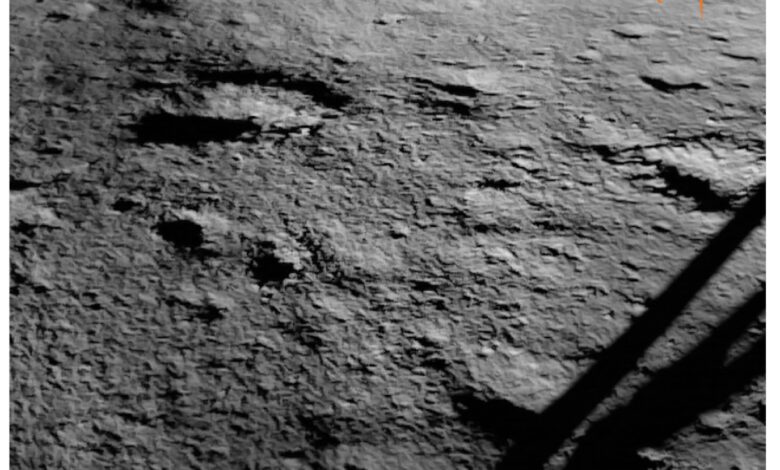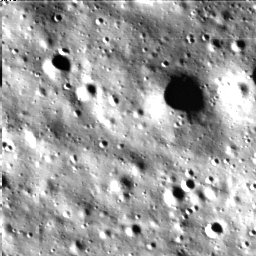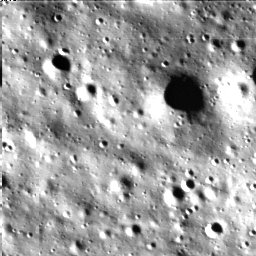Historic Achievement: ISRO’s Chandrayaan-3 Executes Precise Lunar Landing, Garnering International Applause

In an impressive feat of precision, the Indian Space Research Organisation (ISRO) has accomplished the landing of Chandrayaan-3 on the moon’s surface, solidifying the country’s prominence in space exploration. The successful landing, meticulously calculated by space scientists, has propelled India to become the sole nation to achieve a triumphant lunar landing at the moon’s southern pole. Commendations and well wishes have poured in from various quarters, including NASA, ESA, and other renowned space agencies, acknowledging ISRO’s triumphant mission.
ISRO Shares Captivating Images: A Glimpse of the Accomplishment
Accompanying this milestone is a series of captivating images released by ISRO. Captured by the Landing Imager Camera, these visuals offer a remarkable glimpse of Chandrayaan-3’s landing site. A leg of the spacecraft, accompanied by its shadow, stands as a testament to the successful landing. Moreover, ISRO has shared Moon images acquired by the Lander Horizontal Velocity Camera during the descent, showcasing the lunar surface in intricate detail.
Communication Triumph: Link Established Between Ch-3 Lander and MOX-ISTRAC, Bengaluru
Communication channels have been triumphantly established between the Ch-3 Lander and MOX-ISTRAC in Bengaluru, confirming the seamless connection between the lunar craft and its mission control. This successful communication marks a vital step in facilitating data transmission and control during the mission’s progression.
Chandrayaan-3’s Strategic Landing Choice
Chandrayaan-3 strategically chose a relatively level expanse on the lunar landscape for its landing. This meticulous selection was aimed at ensuring a secure and precise landing, further underlining the mission’s success.
Specifications at a Glance
Chandrayaan-3’s specifications underscore its technological prowess and mission design:
- Mission Life (Lander & Rover): Approximately one lunar day, equivalent to about 14 Earth days.
- Landing Site (Prime): The chosen site spans 4 km x 2.4 km, situated at coordinates 69.367621 S, 32.348126 E.
- Science Payloads: The mission boasts a range of scientific instruments, including those on the Lander like RAMBHA, ChaSTE, ILSA, and LRA, as well as the Rover’s APXS and LIBS, and the Propulsion Module’s SHAPE payload.
- Two Module Configuration: Comprising the Propulsion Module responsible for carrying the Lander from launch injection to lunar orbit, and the Lander Module housing the Rover internally.
- Mass: The Propulsion Module weighs 2148 kg, the Lander Module is 1752 kg (including a 26 kg Rover), totaling 3900 kg.
- Power Generation: The Propulsion Module generates 758 W, the Lander Module produces 738 W with a WS bias, and the Rover generates 50 W.
- Communication: The Propulsion Module communicates with IDSN, the Lander Module communicates with IDSN and the Rover, while the Chandrayaan-2 Orbiter serves as a contingency link.
- Lander Sensors: Equipped with advanced sensors such as LIRAP, KaRA, LPDC, LHDAC, LASA, LDV, LHVC, Micro Star sensor, and inclinometer & touchdown sensors.
- Lander Actuators: Featuring 4 reaction wheels (10 Nms & 0.1 Nm) for precise control.
- Lander Propulsion System: Employing a Bi-Propellant Propulsion System (MMH + MON3), with 4 800 N Throttleable engines & 8 58 N Throttleable Engine Control Electronics.
- Lander Mechanisms: Encompassing the Lander leg, Rover Ramp (Primary & Secondary), Rover, ILSA, Rambha & Chaste Payloads, umbilical connector protection mechanism, and an X-Band Antenna.
- Lander Touchdown Specifications: Vertical velocity ≤ 2 m/sec, horizontal velocity ≤ 0.5 m/sec, and slope ≤ 12 degrees.
Scientific Payload Objectives: A Quest for Lunar Understanding
The Lander Payloads:
- Radio Anatomy of Moon Bound Hypersensitive Ionosphere and Atmosphere (RAMBHA): Houses a Langmuir probe (LP) to measure plasma density variations near the surface over time.
- Chandra’s Surface Thermo physical Experiment (ChaSTE): Facilitates thermal property measurements of the lunar surface, particularly in the polar region.
- Instrument for Lunar Seismic Activity (ILSA): Monitors seismic activity around the landing site, contributing to the understanding of lunar crust and mantle structures.
- LASER Retroreflector Array (LRA): A passive experiment providing insights into the dynamics of the Moon system.
The Rover Payloads:
- LASER Induced Breakdown Spectroscope (LIBS): Conducts qualitative and quantitative elemental analysis, enhancing understanding of lunar surface composition.
- Alpha Particle X-ray Spectrometer (APXS): Determines the elemental composition (Mg, Al, Si, K, Ca, Ti, Fe) of lunar soil and rocks near the landing site.
The Propulsion Module Payload:
- Spectro-polarimetry of Habitable Planet Earth (SHAPE): Aims to enable the exploration of exoplanets by analyzing reflected light, potentially revealing habitability and the presence of life.
With these accomplishments and meticulous engineering, Chandrayaan-3 advances India’s scientific prowess and establishes the nation as a key player in lunar exploration.






